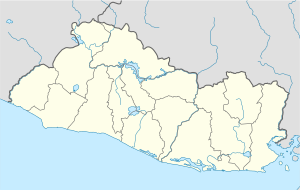Agua Caliente, El Salvador facts for kids
Quick facts for kids
Agua Caliente
|
|
|---|---|
|
Municipality
|
|
| Country | |
| Department | Chalatenango Department |
| Elevation | 381 m (1,250 ft) |
Agua Caliente is a town in El Salvador. It is a municipality located in the Chalatenango department. The town is north of Chalatenango, which is the capital city of the department.
Agua Caliente covers an area of about 195 square kilometers. In 2006, its population was around 8,992 people. The name "Agua Caliente" means "Hot Water" in Spanish. This name comes from the hot springs found in the area.
Contents
History of Agua Caliente
According to old records, in 1807, Agua Caliente was a large farm. It was owned by Bernardino Aguilar and used for raising cattle and growing indigo plants. Indigo was used to make blue dye.
In 1819, this farm grew into a small village. It was given the long name of San Jose Agua Caliente de las Flores. This new village became part of the Tejutla Region.
Over the years, Agua Caliente belonged to different departments in El Salvador. From 1824 to 1833, it was part of the San Salvador department. Then, it moved to the Tejutla department in 1833. It went back to San Salvador from 1833 to 1835. From 1835 to 1855, it was part of the Cuzcatlan department. Since 1855, Agua Caliente has been a municipality within the Chalatenango department. By 1890, about 2,340 people lived there.
Life in Agua Caliente
Agua Caliente is mainly a community focused on farming and raising animals. You can find good prices on cheese and dairy products made locally in some stores.
Community Life
In the center of Agua Caliente, there is a Catholic church. This church is a beautiful old building. It looks grander than churches in nearby towns. There's a story that the huge bell in one of its towers is a copy. The original bell was supposedly stolen and taken to a famous church in Ahuachapan a long time ago.
Every Thursday morning, from about eight to eleven, there is a lively market in the streets. This is when most people from nearby small villages, called "cantones," come to buy food and clothes. They also come to sell their cattle or farm products. Visitors can try a pupusa, which is a traditional Salvadoran dish, at a local pupuseria.
Local Economy
During the 1980s, many people from Agua Caliente moved to other countries, like Australia and Europe. This was a difficult time for the town. When these people started buying land back in Agua Caliente, land prices went up a lot. It's now common to see houses priced at $50,000, which was very rare twenty-five years ago. Some families in Agua Caliente rely on money sent to them by relatives living in the United States.
Natural Features
The town's name, "Agua Caliente," comes from its warm water lagoon and hot springs. The Metayate River flows through the town, dividing it into two main areas called "barrios": El Carmen and El Centro. Over time, the river's water flow has decreased because many trees on the surrounding hills have been cut down.
One of the hills near Agua Caliente has a huge rock called "La Piedra Movediza," which means "The Moving Rock." This rock can be moved with a little effort because of its natural balance.
Festivities
The town celebrates its main festivities on March 18th and 19th. These celebrations are dedicated to Saint Joseph, who is the patron saint of Agua Caliente.
See also
 In Spanish: Agua Caliente (El Salvador) para niños
In Spanish: Agua Caliente (El Salvador) para niños


